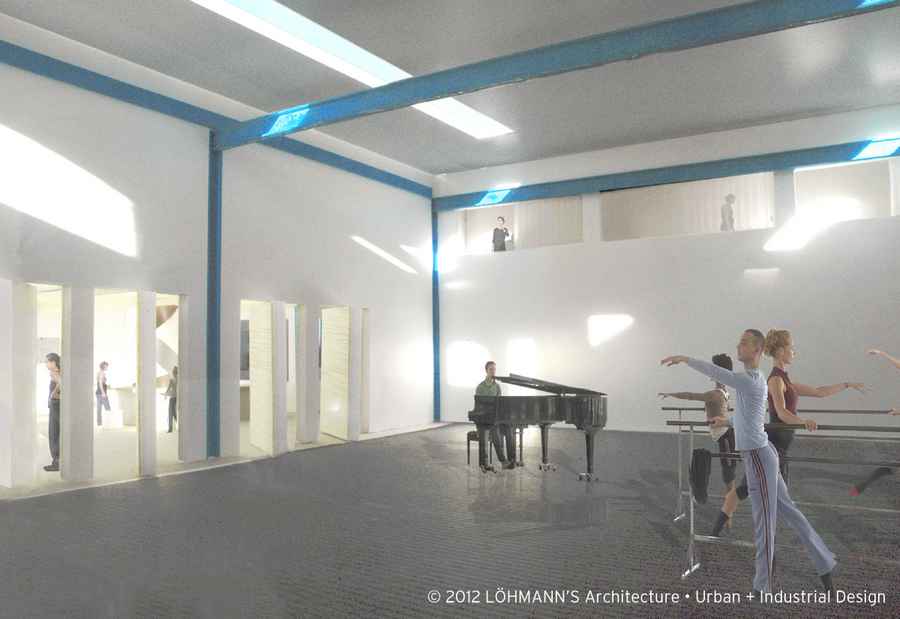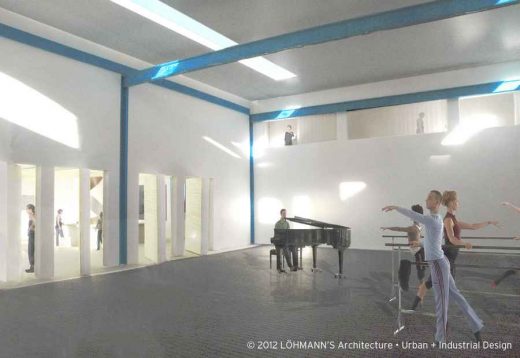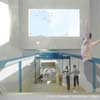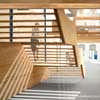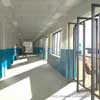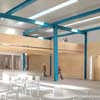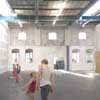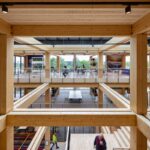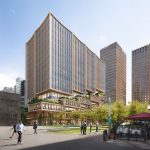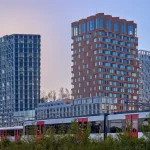Dance House IJ, STORK Factory Amsterdam, SBDA Netherlands design architect
Dance House Amsterdam : Former STORK Factory
Contemporary Dutch Building design by LÖHMANN’S Architecture • Urban + Industrial Design.
post updated 28 December 2024
Design: LÖHMANN’S Architecture • Urban + Industrial Design
Former STORK Factory Redevelopment – Stichting Beheer Danshuis Amsterdam
Developing a dance house in an old factory building on the IJ is a feasible project
31 May 2012
Dance House IJ
A report by LÖHMANN’S Architecture • Urban + Industrial Design, in collaboration with the Amsterdam Dance House Foundation (SBDA)
For almost 20 years, initiators from the Amsterdam professional dance field have tried to establish a house for the dance sector. A number of different locations and scenarios have been explored, but until now, none have come to fruition. A Dance House should provide the physical infrastructure needed to maintain the leading position of the Amsterdam (and Dutch) contemporary dance scene, and in these days of funding cuts for the arts, also be affordable. At the end of 2010 the possibility of a new ‘state-of-the-art’ building in the east of Amsterdam fell through because of economic uncertainties. A new option of establishing a house in the former STORK factory on the bank of the river IJ offers a realistic and exciting alternative.
The professional contemporary dance scene in Amsterdam is internationally known and respected. The city is home to many talented choreographers and dancers, both Dutch and ‘Dutch based’, from all over the world, who have chosen to live and work in the city. A wide variety of styles in both contemporary and classically based dance are represented, making it a rich and varied scene.
This situation has been encouraged by the support of the Dutch government and the municipality of Amsterdam, which has found it important to attract many professional creative people and visitors interested in all kinds of arts.
A growing demand for large, affordable, and professionally-equipped studio spaces together with the wish to create a common place for artistic exchange, gave rise years ago to an initiative to establish a dance house in Amsterdam. This came originally from the large freelance field, which needed proper facilities in which to train, rehearse and produce performances, but was later embraced by a number of companies who saw the advantages of shared housing and professional synergy.
Recent political and financial developments in the Netherlands have led to drastic cuts in arts funding, and have increased the urgency of creating a more centralized physical space in the Amsterdam dance scene where costs and facilities can be shared. Developing new talent and creating productions in such a space can be done more efficiently, as facilities for training, rehearsal, and montage are all in one place. Furthermore the possibility of having a vibrant meeting place for dance artists and public is also seen as a great advantage.
Against this backdrop, the municipality of Amsterdam commissioned the Dance House Foundation (Stichting Beheer Danshuis Amsterdam) to do a feasibility study for a possible dance house in an old and empty factory building on the bank of the central body of water in the city called the IJ. LÖHMANN’S Architecture • Urban + Industrial Design was called upon to carry out the study together with the Foundation.
The research is comprised of three parts. The first part gives insight into the actual spatial situation of the different dance institutions in Amsterdam, including companies, production houses, and training centres. The collection of questionnaires handed out to the institutions are translated in diagrams which visualize the range of studio sizes but also the use of these spaces throughout the year, and what type of activities are carried out at what times of the day.
The second part is a comparative analysis of five existing European dance houses. It is the first time that this type of research about dance houses is done. Because the typology of dance houses is a very young phenomenon, there is almost no existing literature and certainly no comprehensive research had been done about the architectural aspect of it.
Interviews with the directors, users, and staff members, together with the analysis of the spaces and functions of these dance houses, as well as their sizes, spatial organisation, dealing with daylight, acoustics and the materialisation of the spaces, provided the knowledge needed in order to build up the functional and spatial requirements for a well-functioning dance house.
The third part of the research organises the spatial functions such as rehearsal, training and montage studio’s, changing rooms, offices, and a public foyer into two possible scenarios within the existing space of the factory building. Preserving the special qualities of the building and arranging the needed spaces in a ‘spatial choreography’ are the conditions that form the architectural basis for these concepts.
The feasibility study shows that using the existing building ‘envelope’ saves about six million Euros compared to constructing a new building. Included in the study is the research of five existing European dance houses in London, Düsseldorf, Oslo, Newcastle and Zürich. With this additional study LÖHMANN’S shows the valuable impact of a Dance House in fostering both local and national artistic development, as well as increasing the visibility of the dance discipline to public and educational institutions. Furthermore, the relatively informal and open character of a Dance House can contribute to creating a vibrant neighbourhood as well as to stimulating wide participation in the arts.
The municipality of Amsterdam will decide at the end of 2012 about giving financial support to the initiative to establish a modest but upgradable Dance House Amsterdam in the factory hall on the IJ.
Website of the Amsterdam Dance House Foundation www.danshuis.nl
About LÖHMANN’S Architecture • Urban + Industrial Design
LÖHMANN’S Amsterdam was founded in 1997 by the German architect Heike Löhmann. Since then the office has realized a significant amount of high quality projects, often for creative and demanding clients with specific spatial requirements. The projects are distinguished by their spatial proportions, detailing, and for their elaborated choice and combination of materials.
LÖHMANN’S speciality is an integral approach to the interweaving of the various scales in a project.
LÖHMANN’S is particularly interested in projects that offer an opportunity to give an unexpected twist to a seemingly obvious way of conceiving and perceiving space. The ordinary is put in a new perspective with a well-considered and subtle use of architectonic means.
Dance House Amsterdam images / information from LÖHMANN’S Architecture • Urban + Industrial Design
Amsterdam Dance House Foundation Address:
Stichting Beheer Danshuis Amsterdam
p/a Kinkerstraat 140
1053 EG, Amsterdam
Location of the Amsterdam Dance House project: next to Gedempt Hamerkanaal 96, in 1021 KR Amsterdam (opposite of Motorkanaal 11-14)
Location: Gedempt Hamerkanaal 96, Amsterdam, The Netherlands
Amsterdam Architecture
House IJburg
Design: Marc Koehler Architects

photo : Marcel van der Burg (Primabeeld)
Ijburg House
Floating House IJburg
Hollands Zicht & SOOH

photo © Katja Effting
Floating House IJburg
IJburg House by Gabriëls Webb
Theater Fabriek Amsterdam
Czaar Peterstraat 213,1018 PL Amsterdam, Netherlands 020 5356949
Amsterdam Architecture – contemporary building information
Amsterdam Buildings – historic building information
Dutch Architectural Designs
Major New Dutch Buildings
Netherlands Architecture Designs – chronological list
Comments / photos for the Dance House Amsterdam IJ – Former STORK Factory Building design by LÖHMANN’S Architecture • Urban + Industrial Design page welcome.

